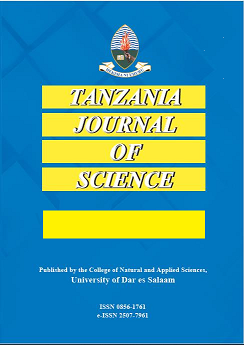Heavy metals in green vegetables and soils from vegetable gardens in Dar es Salaam, Tanzania
Abstract
Edible portions of five varieties of green vegetables, namely amaranth, chinese cabbage, cowpea leaves, leafy cabbage and pumpkin leaves, collected from several areas in Dar es Salaam, were analyzed for lead, cadmium, chromium, zinc, nickel and copper. Except for zinc, the levels of heavy metals in the vegetables grown at Tabata area were much higher than in the vegetables from Ukonga and Kiwalani. Amaranth and pumpkin leaves had more than 60% higher content of heavy metals, especially copper, chromium and lead, than the other vegetables. All vegetables from Tabata, Buguruni and Sinza had lead-levels higher then the FAO/WHO recommended permissible levels in foods. Amaranth, leafy and chinese cabbages had high zinc content. Zinc levels in chinese cabbage and leafy cabbage from Kiwalani, Sinza and Ukonga areas were higher than the permissible FAO levels in foods. The soils from Tabata and Sinza areas had high levels of lead, chromium, zinc and copper while the soils from Kiwalani, Makongo and Ukonga areas had high levels of zinc and copper. There was a direct positive correlation between the zinc and lead levels in soils with the levels in vegetables. Such relation was absent for the other heavy metals. Considering an average daily intake of only 202g of fresh vegetables per person per day, all the vegetables grown at Tabata and Buguruni had lead concentration which would be a health hazard for human consumption.


